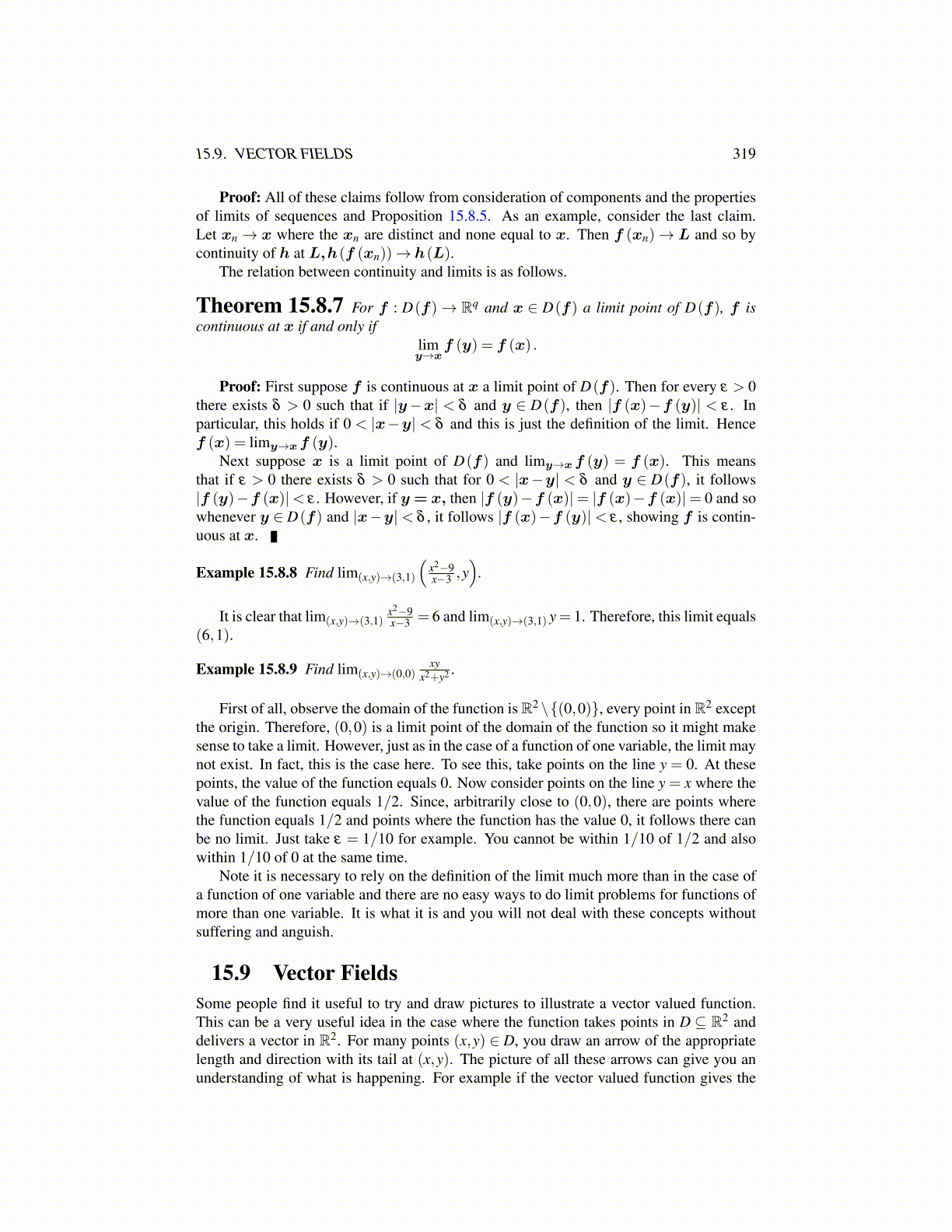
15.9. VECTOR FIELDS 319
Proof: All of these claims follow from consideration of components and the propertiesof limits of sequences and Proposition 15.8.5. As an example, consider the last claim.Let xn → x where the xn are distinct and none equal to x. Then f (xn) → L and so bycontinuity of h at L,h(f (xn))→ h(L).
The relation between continuity and limits is as follows.
Theorem 15.8.7 For f : D(f) → Rq and x ∈ D(f) a limit point of D(f), f iscontinuous at x if and only if
limy→x
f (y) = f (x) .
Proof: First suppose f is continuous at x a limit point of D(f). Then for every ε > 0there exists δ > 0 such that if |y−x| < δ and y ∈ D(f), then |f (x)−f (y)| < ε . Inparticular, this holds if 0 < |x−y| < δ and this is just the definition of the limit. Hencef (x) = limy→xf (y).
Next suppose x is a limit point of D(f) and limy→xf (y) = f (x). This meansthat if ε > 0 there exists δ > 0 such that for 0 < |x−y| < δ and y ∈ D(f), it follows|f (y)−f (x)|< ε . However, if y = x, then |f (y)−f (x)|= |f (x)−f (x)|= 0 and sowhenever y ∈ D(f) and |x−y|< δ , it follows |f (x)−f (y)|< ε , showing f is contin-uous at x.
Example 15.8.8 Find lim(x,y)→(3,1)
(x2−9x−3 ,y
).
It is clear that lim(x,y)→(3,1)x2−9x−3 = 6 and lim(x,y)→(3,1) y= 1. Therefore, this limit equals
(6,1).
Example 15.8.9 Find lim(x,y)→(0,0)xy
x2+y2 .
First of all, observe the domain of the function is R2 \{(0,0)}, every point in R2 exceptthe origin. Therefore, (0,0) is a limit point of the domain of the function so it might makesense to take a limit. However, just as in the case of a function of one variable, the limit maynot exist. In fact, this is the case here. To see this, take points on the line y = 0. At thesepoints, the value of the function equals 0. Now consider points on the line y = x where thevalue of the function equals 1/2. Since, arbitrarily close to (0,0), there are points wherethe function equals 1/2 and points where the function has the value 0, it follows there canbe no limit. Just take ε = 1/10 for example. You cannot be within 1/10 of 1/2 and alsowithin 1/10 of 0 at the same time.
Note it is necessary to rely on the definition of the limit much more than in the case ofa function of one variable and there are no easy ways to do limit problems for functions ofmore than one variable. It is what it is and you will not deal with these concepts withoutsuffering and anguish.
15.9 Vector FieldsSome people find it useful to try and draw pictures to illustrate a vector valued function.This can be a very useful idea in the case where the function takes points in D ⊆ R2 anddelivers a vector in R2. For many points (x,y) ∈ D, you draw an arrow of the appropriatelength and direction with its tail at (x,y). The picture of all these arrows can give you anunderstanding of what is happening. For example if the vector valued function gives the